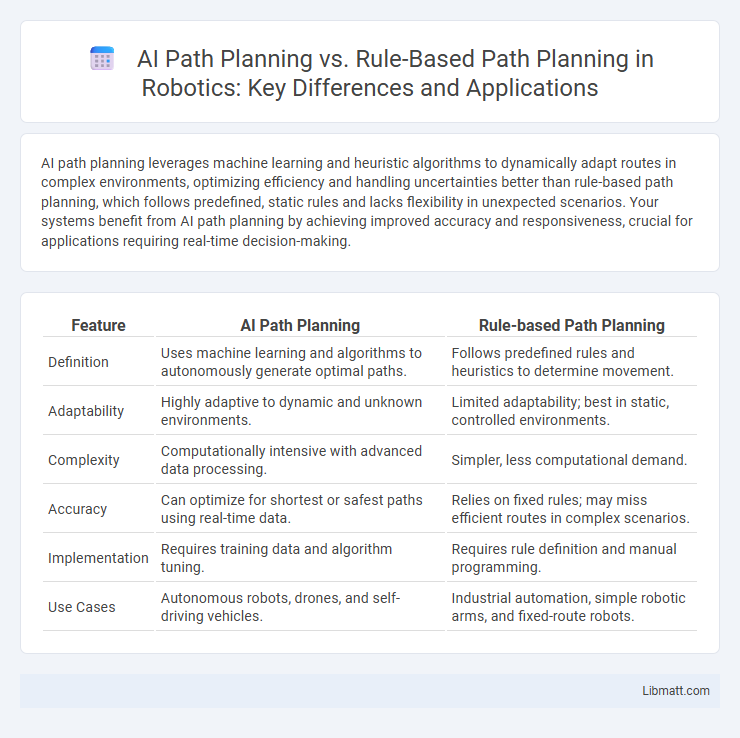AI path planning leverages machine learning and heuristic algorithms to dynamically adapt routes in complex environments, optimizing efficiency and handling uncertainties better than rule-based path planning, which follows predefined, static rules and lacks flexibility in unexpected scenarios. Your systems benefit from AI path planning by achieving improved accuracy and responsiveness, crucial for applications requiring real-time decision-making.
Table of Comparison
| Feature | AI Path Planning | Rule-based Path Planning |
|---|---|---|
| Definition | Uses machine learning and algorithms to autonomously generate optimal paths. | Follows predefined rules and heuristics to determine movement. |
| Adaptability | Highly adaptive to dynamic and unknown environments. | Limited adaptability; best in static, controlled environments. |
| Complexity | Computationally intensive with advanced data processing. | Simpler, less computational demand. |
| Accuracy | Can optimize for shortest or safest paths using real-time data. | Relies on fixed rules; may miss efficient routes in complex scenarios. |
| Implementation | Requires training data and algorithm tuning. | Requires rule definition and manual programming. |
| Use Cases | Autonomous robots, drones, and self-driving vehicles. | Industrial automation, simple robotic arms, and fixed-route robots. |
Introduction to Path Planning Methods
AI Path Planning utilizes machine learning algorithms and probabilistic models to dynamically navigate complex environments by predicting optimal routes based on real-time data. Rule-based Path Planning relies on predefined sets of heuristics or rules to determine paths, often resulting in deterministic and less adaptable navigation. AI approaches excel in handling uncertainty and variations, while rule-based methods offer simplicity and predictability in controlled scenarios.
Overview of AI Path Planning
AI Path Planning employs advanced algorithms such as A* and Dijkstra to dynamically calculate optimal routes in complex environments, adapting to changes and obstacles in real-time. Unlike rule-based path planning, which follows predefined instructions and lacks flexibility, AI path planning leverages machine learning techniques and sensor data to improve navigation efficiency. Your system can benefit from AI path planning by achieving more accurate, efficient, and autonomous decision-making for route selection.
Understanding Rule-based Path Planning
Rule-based path planning relies on predefined sets of rules and heuristics to navigate environments, offering predictable and interpretable paths ideal for structured settings. Unlike AI path planning, which adapts through learning from data and dynamic inputs, rule-based methods lack flexibility but excel in scenarios requiring deterministic behavior. These systems are often simpler to implement and verify, making them suitable for applications with well-defined constraints and limited environmental variability.
Core Differences Between AI and Rule-based Path Planning
AI path planning leverages machine learning algorithms and heuristic search techniques to dynamically adapt routes based on environmental changes and sensor inputs, enhancing flexibility and responsiveness. Rule-based path planning relies on predefined, static rules and conditions for navigation, providing predictable, deterministic paths but limited adaptability to complex or unforeseen scenarios. The core difference lies in AI's capability for continuous learning and optimization versus rule-based systems' dependence on fixed decision trees and logical constructs.
Advantages of AI Path Planning
AI path planning offers superior adaptability and efficiency by learning from dynamic environments, enabling real-time route optimization that surpasses static, pre-defined rule-based methods. It can handle complex scenarios with unpredictable obstacles, improving navigation accuracy and reducing travel time. Your systems benefit from AI's ability to continuously refine paths through machine learning algorithms, enhancing overall performance in autonomous navigation.
Advantages of Rule-based Path Planning
Rule-based path planning offers clear advantages in simplicity and predictability, making it easier to implement and debug compared to AI path planning. It ensures consistent decision-making through predefined rules, which is particularly beneficial in environments with strict safety or regulatory requirements. Your systems can achieve fast, reliable navigation without the need for extensive training data or computational resources.
Limitations of AI Path Planning
AI path planning faces limitations such as high computational costs and the need for extensive training data, which can hinder real-time applications in dynamic environments. It may struggle with generalization when encountering scenarios outside its training distribution, leading to suboptimal or unsafe paths. Unlike deterministic rule-based path planning, AI models can be less interpretable, making validation and debugging more challenging in safety-critical systems.
Limitations of Rule-based Path Planning
Rule-based path planning faces limitations in dynamic and complex environments due to its reliance on predefined rules that cannot adapt to unforeseen obstacles or changes. This approach struggles with scalability as the complexity of scenarios increases, leading to rigid navigation patterns and potential failure in real-time decision-making. In contrast, AI path planning leverages machine learning and optimization techniques to enable more flexible, adaptive, and efficient route generation.
Application Scenarios and Use Cases
AI path planning excels in dynamic and complex environments such as autonomous vehicles navigating urban streets and drones performing search and rescue missions, where real-time decision-making and adaptation to unpredictable obstacles are crucial. Rule-based path planning is ideal for structured settings like factory automation and warehouse logistics, where predefined routes and consistent conditions minimize the need for on-the-fly recalculations. AI's ability to learn from data and optimize routes under uncertainty contrasts with the deterministic nature of rule-based systems, making each suitable for different operational requirements and safety constraints.
Future Trends in Path Planning Technologies
Future trends in AI path planning emphasize adaptive algorithms leveraging deep learning and reinforcement learning to navigate complex, dynamic environments with greater efficiency than traditional rule-based systems. While rule-based path planning relies on predefined heuristics and static rules, AI-driven methods continuously learn from real-time data, improving obstacle avoidance and route optimization in autonomous vehicles and robotics. Your ability to integrate these advanced AI models will be critical for developing smarter, more responsive path planning solutions in emerging autonomous technologies.
AI Path Planning vs Rule-based Path Planning Infographic

 libmatt.com
libmatt.com